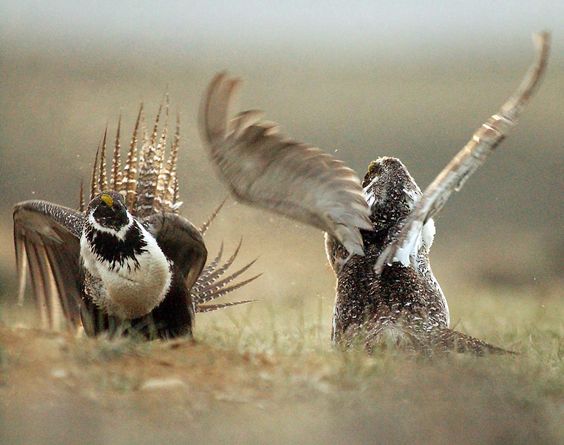The Greater Sage-Grouse is a large ground-dwelling bird that
has finely stamped brown, black, beige and white upper parts, a dark stomach,
and a since a long time ago pointed tail. It is the largest grouse species
found in North America. Inside the white bosom plumes of the male Greater
Sage-Grouse, there are two substantial air sacs that are expanded and emptied
as a major aspect of an awesome mating show.
Greater Sage-Grouse are found in Canada's southernmost local
prairies where sagebrush develops. In particular, they are found in
southwestern Saskatchewan and southeastern Alberta. There are likewise
populaces found in the prairies of the United States.
Males Males are larger than females and game a white ruff
around their necks notwithstanding the run of the mill mottled dark colored,
highly contrasting plumage. Males have splendid yellow air sacks on their
bosoms, which they blow up amid their mating show.
Females Females are a mottled brown, black, and white.
Size Typically 30 crawls long and up to 2 feet tall; Males
frequently say something overabundance of 4-5 pounds and hens tip the scales at
2-3 pounds.
Habitat Sage-grouse are meaningful of the sagebrush steppe of the
intermountain West, which is their solitary living space. They are far reaching
over the sagebrush fields however are delicate to aggravation. In late-winter
they accumulate on patches of open ground known as leks, where males show to
females.
Behavior Male greater sage-grouse collect at public show
grounds—called leks—to swagger their stuff with expectations of charming a
female. To establish a decent connection, the males fan out their spiked tail
plumes and swell their brilliant, bulbous chest sacs. At the point when the
bird breathes in enough air to fill the sacs, his chest nearly looks like a
couple of radiant side-up eggs.
The male's move incorporates washing his wings and letting
out a progression of low cooing sounds. The coos are trailed by two popping
sounds with a shriek in the middle. As a finale, the male raises his take and
lets off a huffing sound. Females additionally deliver calls to get the
consideration of males on the leks.
Diet For the most part sage leaves and buds, additionally creepy
crawlies. Eating routine in fall and winter might be for the most part the
leaves and crisp shoots of sagebrush. At different seasons, additionally eats
leaves, blooms, and buds of a wide assortment of plants; likewise a few creepy
crawlies in summer. Not at all like most grouse, had stomach related framework
isn't adjusted for digesting hard seeds.
Color Sage-grouse are mottled gray-brown with a black belly. Males
have a pimple and throat. The bosom has a fleecy white ruff that, amid shows,
encompasses a couple of inflatable, yellow air sacs. Females have a gloomy
cheek fix underscored by white markings behind the eye.
Nesting Traditional display grounds might be utilized for quite a
long time. In romance show, male puffs out white chest, blows up two yellow air
sacs, raises and spreads tail, hangs wings; head is tossed back on shoulders as
air sacs are flattened with boisterous popping sound. Females visit show ground
to mate with one of the males. Most seasoned and most experienced males go
after positions at focal point of show ground, and these males are typically
picked by females.
Fun Fact In spite of the fact that they like to walk, greater
sage-grouse have been recorded flying up to 48 miles 60 minutes. Since their
short legs make it hard to run, they typically fly or cover up to sidestep a
risk.
Here's Some Beautiful Pictures Of Greater sage-grouse:
Thanks and If You Like,Then Please Share with Your FriendSs..




















No comments:
Post a Comment